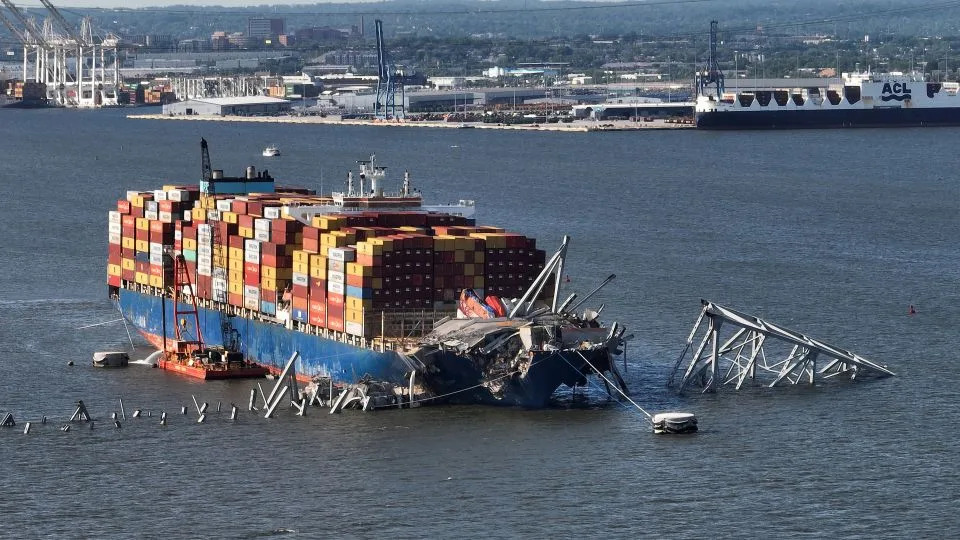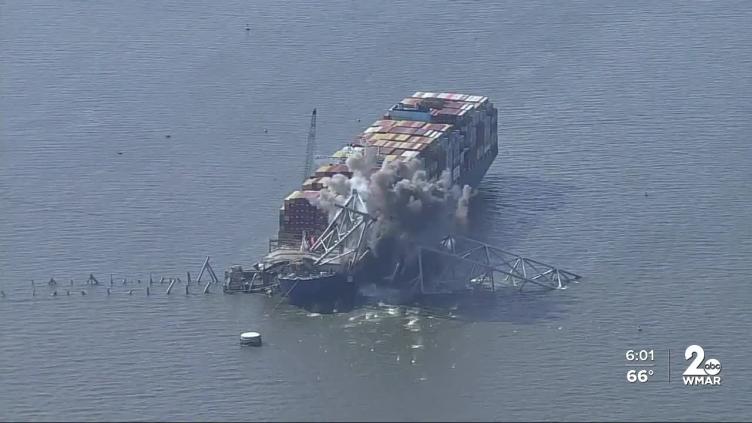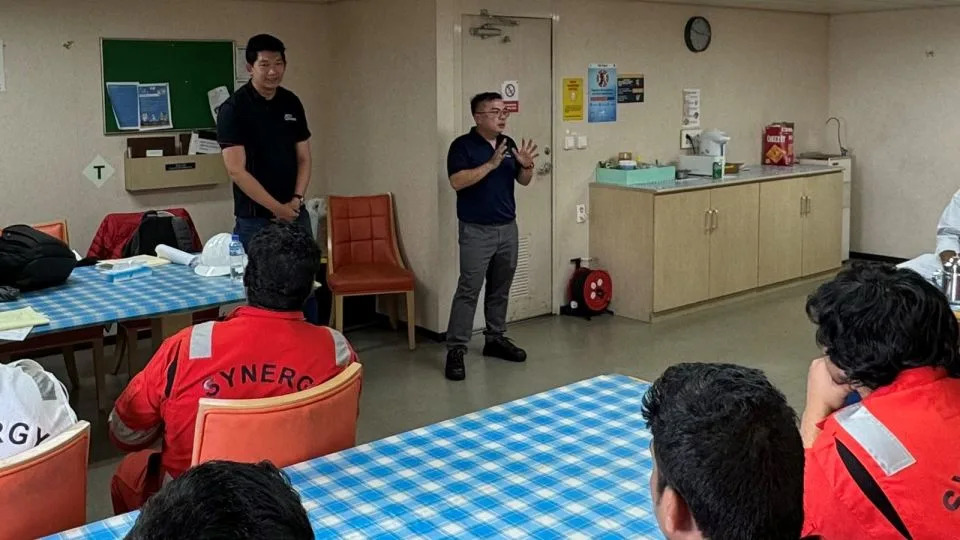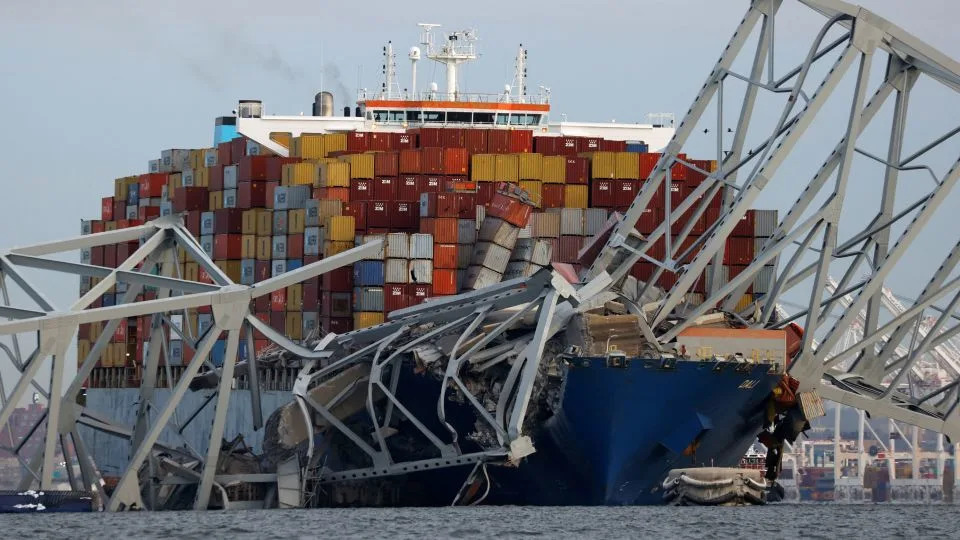Amanda Musa and Zoe Sottile, CNN
Sat, May 18, 2024

Almost two months after its devastating collision with a Baltimore bridge, the trapped cargo ship Dali will refloat and travel to the Baltimore marine terminal on Monday morning, officials said.
After weeks of salvage operations, the Dali can finally be relocated thanks to a series of controlled explosions which broke apart a massive piece of the Francis Scott Bridge that had been stuck atop the ship’s bow, officials said. An estimated 500-foot section of the bridge weighing 8-12 million pounds was removed from the ship.
“The refloat and transit sequence is deliberately designed to ensure all response personnel around the M/V Dali maintain control of the vessel, from refloat, transit to, and berthing at a local marine terminal,” Unified Command said in a news release Saturday.
Conditions permitting, the massive ship’s journey will begin around 5 a.m. on Monday during peak high tide, according to Unified Command. Crews will begin prepping the ship about 18 hours before – about midday on Sunday – to take full advantage of the high tide, officials added.
Up to five tugboats will then tow and push the Dali about two and a half miles to the Seagirt Marine Terminal in Baltimore, the release said. It will take an estimated three hours to transport the 984-foot, 106,000-ton ship.
The cargo ship collided with the bridge in the early hours of March 26, killing six maintenance workers and causing most of the structure to collapse into the Patapsco River. The disaster shut down most shipping to and from the Port of Baltimore.
The crash has prompted multiple investigations, including by the FBI and the US Coast Guard.
The ship’s 21-member crew has remained onboard since the collapse, including during the planned explosions on May 13. The ship’s management company told CNN this week the crew will remain on the vessel for “the foreseeable future.”
CNN’s Yan Kaner contributed to this report.
Cargo ship at Baltimore Key Bridge collapse site to be refloated, moved
WDVM Hagerstown
Sat, May 18, 2024

After Monday's controlled demolition of the piece of steel lying across the Dali, officials expected to refloat the ship about two days later. That time has come and gone. The complicated work is taking longer than anticipated. Newly released video from the Unified Command, which you can watch in the clip above, shows crews on board the Dali as they continue clearing the wreckage
Congressional panel debates who should foot the bill for rebuilding Baltimore bridge
Jacob Fischler
Sat, May 18, 2024

Debris is cleared from the collapsed Francis Scott Key Bridge as efforts begin to reopen the Port of Baltimore on March 31, 2024, in Baltimore, Maryland. The bridge, which was used by roughly 30,000 vehicles each day, fell into the Patapsco River after being struck by the Dali, a cargo ship leaving the port at around 1:30 a.m. on March 26. (Photo by Tasos Katopodis/Getty Images)
Conservative members of Congress at a hearing on Wednesday raised questions about using federal dollars to pay for rebuilding a state tollway, as the head of the Federal Highway Administration reiterated that the Biden administration is seeking congressional approval to reimburse 100% of the costs of rebuilding the Francis Scott Key Bridge in Baltimore.
Congress has about six months left to adjust the federal share of costs to reconstruct the bridge before an automatic rate of 90% reimbursement kicks in, House Transportation and Infrastructure Chairman Sam Graves, a Missouri Republican, said at a hearing on the federal response to the March 26 collapse.
Early that morning, the container ship Dali lost power and struck the bridge, which collapsed into the Patapsco River and blocked access to the busy Port of Baltimore. Six people died.
Under the FHWA’s Emergency Relief Program, the federal government covers the first nine months of costs from a disaster.
Graves did not indicate whether he thought Congress should increase the federal cost-share. But Federal Highway Administrator Shailen Bhatt repeated President Joe Biden’s pledge that the federal government would cover all costs.
“The administration is asking Congress to join in demonstrating a commitment to aid in recovery efforts by authorizing a 100% federal cost-share for rebuilding the bridge, consistent with past catastrophic bridge collapses,” Bhatt told the panel.
The federal government reimbursed all the costs to rebuild the I-35W bridge in Minneapolis after it collapsed in 2007, Bhatt said.
The estimated cost of a rebuild for the Baltimore bridge is $1.7 billion to $1.9 billion.
The FHWA has asked permitting agencies to speed up approvals for a new bridge, noting that environmental and other reviews should consider that a bridge with a similar footprint was previously in the same location, Bhatt said.
Conservatives on the panel drew attention to the fact that the bridge, which was a toll facility on Maryland’s highway system, had never received federal funding. Revenue from the tolls go to the state, Pennsylvania Republican Scott Perry, noted.
Perry, a member of the far-right House Freedom Caucus, said the comparison to the Minneapolis bridge collapse was not apt because it had not been a toll bridge.
He asked if the federal government could recoup toll money collected on the bridge when it reopens.
“I hope you would consider a plan to reimburse the taxpayer under horrific debt right now, who can’t afford their groceries, their gas bills, their day care bills, for the cost of this bridge, for which one state has been receiving all the money for its entire existence, and apparently is going to receive all the money from the tolls for the rest of its existence,” Perry said.
Interstate system
Bhatt and some Democrats on the panel said that an intact interstate system benefits the entire country.
Georgia Democrat Hank Johnson asked Bhatt to explain the bridge’s connection to interstate commerce, noting that there may be “people in the country who are not inside the state of Maryland who resent having to pay for this bridge reconstruction.”
“What is so critically important for a transportation system is that you can drive from New York to Los Angeles across a system that is completely uniform,” Bhatt responded.
The highway system is connected to ports, which are also economic drivers, Bhatt said.
“This is not just an issue for Maryland,” he said. “It’s an issue for the Northeast Corridor and for our national economy.”
Legal action
Florida Republican Brian Mast asked Bhatt if the government was seeking reimbursement from any insurance policies or the Grace Ocean Private Ltd., which owned the ship, or shipping company Maersk, which chartered it.
Bhatt responded that the U.S. Justice Department was leading efforts to seek to recover those types of funds.
California Democrat John Garamendi said he supported 100% of costs being reimbursed by the federal government, but that the committee should “carefully structure” legislation so that any funds from insurance payments or legal judgments against the shipping company would flow back to the federal government.
Rebuilding issues
Reconstruction plans will be written and updated as the project progresses in the coming years, Bhatt said. The most recent timeline estimates construction could be finished in 2028 and traffic could resume that year or in 2029.
The bridge should be rebuilt to comply with current standards, Bhatt told ranking Democrat Rick Larsen of Washington. The original bridge, constructed during the 1970s, was a truss design, which has been replaced in recent years by cable-stayed bridges.
But federal law does not allow for “betterments” that did not exist on the original bridge to be added to the rebuild, Bhatt added.
The post Congressional panel debates who should foot the bill for rebuilding Baltimore bridge appeared first on Michigan Advance
They’ve been stuck for 7 weeks on the ship that crashed into a Baltimore bridge. This is what life is like for the Dali crew
Holly Yan, CNN
Sat, May 18, 2024
When the Rev. Mark Nestlehutt boarded the Dali cargo ship a week after it crashed into a Baltimore bridge, anxious questions emerged among the 21 crew members:
“When will I get off the ship? When will I be able to get home?”
More than a month later, crew members still don’t know the answers.
They’ve been confined to the ill-fated Dali ever since it lost power, veered off course and crushed the Francis Scott Key Bridge on March 26, killing six construction workers.
Since then, the 20 Indians and one Sri Lankan on board have mourned the deaths of those lives lost, had their cell phones confiscated by the FBI and endured a series of controlled explosions to break apart a massive piece of bridge stuck atop the ship’s bow.
“It has been tough for the seafarers, primarily (because) they know that there’s been loss of life,” said Gwee Guo Duan, assistant general secretary of the Singapore Maritime Officers’ Union, one of the unions representing crew members on the Singaporean-flagged ship.
“It is tough for them, being on board and having to look at the accident site every single day.”
But it could be weeks or even months before they can leave, due to an array of complications – including US visas that expired while they’ve been trapped. Here’s why they’re still stuck on board – and how they’re coping with unimaginable stressors:
Maritime rules say the ship must be staffed
A massive vessel like the 984-foot, 106,000-ton Dali requires constant care – even if it’s not moving. And a ship stuck on a river still faces a host of potential hazards, said Philip C. Schifflin Jr., director of the Center for Mariner Advocacy.
“You can take on water. There’s machinery running … anytime machinery is running, there’s a particular risk of something failing and causing a fire or something like that,” Schifflin said. “So seafarers need to be on board ready to respond to those various hazards. And that’s by law.”
The United States has “minimum requirements for the manning of vessels,” according to the Office of the Federal Register, and similar international regulations have been widely adopted.
“By international maritime regulations, there has to be some crew left on the vessel,” said Nestlehutt, president and executive director of The Seamen’s Church Institute, which promotes the safety and welfare of mariners.
The nonprofit responds to seamen in distress around the world, including those afflicted by hurricanes, pirate incidents or deaths at sea.
When Nestlehutt visited the Dali crew on April 1, he immediately noticed their “sense of great loss and sadness” about the construction workers killed, and the seamen “wanted to let their own family members know that they were safe,” he said.
But days later, the crew lost contact with their families when the FBI seized the crew’s cell phones on April 15 as part of its ongoing investigation into the crash.
‘Unfounded fear’ among the crew members
After the FBI boarded the Dali and seized the seamen’s cell phones, a wave of anxiety permeated the ship, according to a joint statement from the Singapore Maritime Officers’ Union, which represents the ship’s officers, and the Singapore Organisation of Seamen, which represents the other crew members.
The seafarers have since received new cell phones, Duan told CNN Thursday. But the FBI has only returned some of the crew members’ SIM cards, he said.
Although investigators have not blamed any individual for the power outages that led up to the fatal crash, seamen have felt an “Unfounded fear of personal criminal liability,” the two unions representing the crew members said.
“However long the investigation takes, the crew’s rights and welfare should not be infringed upon during its course,” Dave Heindel, president of the Seafarers International Union, said in a statement.
“We call on the authorities to be mindful that seafarers utilize mobile devices to conduct personal business for bill payments and more importantly, transfer money to their home country to sustain families,” he said. “Crew members are becoming demoralized without the basic tools we all take for granted.”

From left: Bro Chen Chuanyi, executive secretary of the Singapore Organisation of Seamen, and Gwee Guo Duan, assistant general secretary of the Singapore Maritime Officers’ Union, speak with seamen aboard the Dali on April 24, four weeks ater the cargo ship crashed into Balitmore's Key Bridge. - Singapore Maritime Officers’ Union/Singapore Organisation of Seamen/ITFMore
“The prolonged detention of MV Dali seafarers aboard their vessel and the failure by authorities to return their personal communication devices are unjust,” Don Marcus, president of the International Organization of Masters, Mates & Pilots, said in a statement last weekend. “Our hearts go out to the Master, Officers and Crew of the M/V Dali, who not only suffered a mortifying and tragic experience resulting in the loss of six lives, but who continue to remain in isolation from their loved ones.”
Stationary, but not sedentary
While they await news about their fates, the crew members are staying busy – not just with their ship duties but also by helping investigators and salvage crews.
“Obviously, this is not a normal environment for them. But they’re all professional seafarers, so they’re doing what they need to do,” said Darrell Wilson, spokesperson for Synergy Marine Group – the company that manages the Dali vessel. “Their days are full. They have normal duties on board. They need to look after the ship, look after equipment, make sure everything is working and functioning that needs to. They’re also assisting with the salvors.”

The Singaporean-flagged Dali cargo vessel is shown on March 26, hours after it destroyed Baltimore's Francis Scott Key Bridge. - Julia Nikhinson/Reuters
The seafarers play a critical role in helping the salvage crews because “they know all the passageways. They know where everything is on the ship,” Wilson said.
“So if somebody has a question about where can we hook up to get running water,” the seafarers can help, Wilson said. “The crew is essentially just assisting in any way possible.”
As for who’s helping the crew members with food, toiletries and other day-to-day necessities, Synergy Marine “dispatched reps here immediately … making sure they have everything they need, helping bring extra supplies on board or arranging for extra supplies to be brought on board,” Wilson said.
In addition, “they have coordinated to have visits by some of the seafarers’ organizations. Some of the seafarers’ ministries have been on. The two respective embassies have been in contact with the crew and even made a visit to the ship,” he said.
Synergy has also provided mental health services for the crew, which Duan – the Singapore Maritime Officers’ Union official – credits for helping a seaman who was traumatized after he frantically tried to search for survivors the night of the deadly crash.
“One of them actually ran to the front of the vessel, which is the bow, to actually try to look for survivors from the accident” – despite the heaps of debris from the bridge that could fall at any moment, Duan said.
On Monday, after six weeks atop the bow of the Dali, a massive piece of the Key Bridge was blown apart in a series of controlled explosions – with the crew still on board.
Many hoped the removal would mean the crew might be able to set sail or at least get off the ship soon. But more hurdles loom.
Their visas expired while they’ve been stuck
In addition to the staffing regulations, the ongoing investigations and questions about whether the Dali is fit to sail, the crew members can’t even set foot on US soil. Their one-month visas expired during the nearly two months they’ve been trapped on the Dali, Duan said.
Even the ship’s management company doesn’t know when the crew can leave.
“They’re going to be on for the foreseeable future,” Wilson told CNN Wednesday. “We’re working to refloat the vessel in a few days and move it to a local terminal here. And then at some point in the future – and I don’t have that date – the company will look for guidance from the authorities on the next steps with the crew.”
Duan, who visited the crew April 24 and communicates with the captain regularly, said he doesn’t expect the ship to leave the Baltimore area until authorities have completed their investigation.
The National Transportation Safety Board released a preliminary report about the crash earlier this week, which did not include a probable cause. Those findings will be part of a final report that could take investigators up to two years to complete.
“Without the final report, I don’t think the vessel is going anywhere” far from Baltimore, Duan said.
In the meantime, he hopes nonessential crew members will be allowed to get off the ship and stay temporarily on dry land to “ease their mental stress.”
The crew members’ unions have publicly called for the extension or renewal of the seamen’s visas. Duan also hopes US authorities will re-evaluate who must stay on the ship, and who might be able to fly home.
‘We take their sacrifices for granted’
The plight of the Dali’s crew highlights the personal sacrifices made by workers who often leave their families for months at a time to provide goods that many consumers use every day.
“I think most of us think of the items that we use on a daily basis show up on Amazon or … Walmart, etc. The reality is 90% of the cargo in the world is carried on vessels,” said Schifflin, the director of the Center for Mariner Advocacy.
“Vessels are manned by seafarers. And to most of us – the vast majority of us – they’re invisible. We don’t even know they’re there. And I think a lot of times, we take their sacrifices for granted.”
CNN’s Gloria Pazmino contributed to this report.
No comments:
Post a Comment